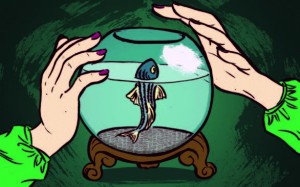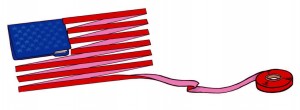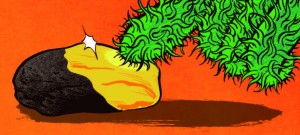WEDNESDAY, 15 MAY 2013
Catch That ThoughtMind reading has just become easier—at least where fish are concerned. In January this year, Akira Muto and colleagues published techniques for visualising neuronal impulses in the brains of zebrafish larvae, which effectively allowed them to track the fishes’ ‘thoughts’ in real time. To do this, they first developed a fluorescent probe sensitive enough to detect the activity of single neurons. They then engineered zebrafish that produce this probe in the visual processing area of their brains. Finally, they presented the fish with a free-swimming Paramecium, a tasty morsel by zebrafish standards, and watched the fluorescent signal dart through the fishes’ brains as they stalked their lunch. Zebrafish larvae are transparent, so the signal was easily visible; indeed, the Paramecium’s path precisely mirrored the pattern of neurons lighting up. One application of this novel technology is the high-resolution mapping of functional neuronal circuits. Since zebrafish and mammalian brains share the same basic organisation, these methods could also be used to screen new psychiatric medications: just add drugs to the fishes’ water and watch the resulting light show. Food for thought indeed. Joy Thompson
Could We Get Another Report, Please?
The United States Secretary of Defence recently gave a speech outlining plans to reduce expenditure by cutting down on the number of costly reports undertaken by the Department of Defence (DOD). In response, the DOD prepared a report to provide guidelines for estimating the costs required for reports to be prepared. Naturally, this report about DOD reports had to be evaluated by the Government Accountability Office (GAO), for which they prepared a report entitled “Defense Management: Actions Needed to Evaluate the Impact of Efforts to Estimate Costs of Reports and Studies”. In their report, they praised the DOD for its report about reports, but recommended a few changes. In particular, the GAO reported that the DOD should evaluate and report on the effectiveness of its report about reports. In the long run, it is hoped that the GAO’s recommendation in its report about a report about reports for a report about the report about reports will cut down on the number of reports. For their efforts, the GAO won the 2012 Ig Nobel Literature Prize (http://www.improbable.com/ig/), but sadly did not show up to receive their award. Jordan Ramsey
Practising Alchemy Before It Was Cool
For humans, alchemy might be a lost art; but in some bacteria, making solid gold from the mundane is simply part of their survival plan. Like many heavy metals, dissolved gold is toxic to life. The bacteria Cupriavidus metallidurans have been shown to swallow up dissolved gold from the environment. They then turn it into solid gold nanoparticles, which are non-toxic and can be stored inside the cells. Recently, a team from McMaster University found that Delftia acidovorans, a bacterium often found alongside C. metallidurans, takes a different approach. Instead of uptaking gold, it produces a novel protein called delftibactin to do the ‘dirty work’. Delftibactin, the alchemist’s secret weapon, turns dissolved gold into solid particles. Thus, toxic gold can no longer enter the bacterial cell and harm the alchemist itself. Last year Adam Brown, Associate Professor from Michigan State University, created the award- winning artwork The Great Work of the Metal Lover, bringing modern microbiological gold-digging to the historical context of ancient alchemy. While we may not see bacteria-run alchemical factories in the near future, researchers suggest delftibactin may be used to accelerate industrial chemical reactions or treat waste waters from mines. Theodosia Woo



